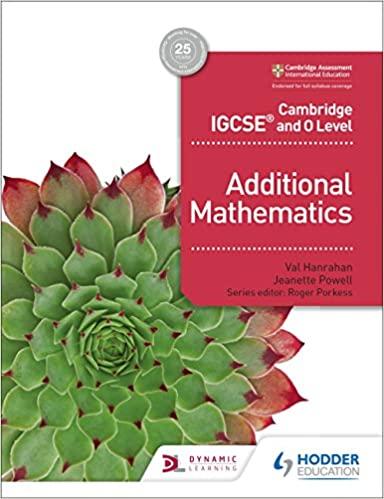Question
The Orthodont data frame, available from the nlme package in R, has 108 rows and 4 columns of the change in an orthdontic measurement over
The "Orthodont" data frame, available from the nlme package in R, has 108 rows and 4 columns
of the change in an orthdontic measurement over time for several young subjects. Investigators
at the University of North Carolina Dental School followed the growth of 27 children (16 males,
11 females) from age 8 until age 14. Every two years they measured the distance between
the pituitary and the pterygomaxillary fissure, two points that are easily identified on x-ray
exposures of the side of the head.
This data frame contains the following columns:
distance a numeric vector of distances from the pituitary to the pterygomaxillary fissure (mm).
These distances are measured on x-ray images of the skull.
age a numeric vector of ages of the subject (yr).
Subject an ordered factor indicating the subject on which the measurement was made. The levels
are labelled "M01" to "M16" for the males and "F01" to "F13" for the females. The
ordering is by increasing average distance within sex.
Sex a factor with levels "Male" and "Female"
You should
1. Appropriate plots of the data.
2. Regress distance on age and Sex and their interaction.
3. Is there any evidence that you should model heterogeneity in these data?
4. Is there any evidence that observations taken on the same subject are correlated with
each other and that this correlation should be modelled?
5. After taking possible heterogeneity/correlation into account, check whether the mean
structure (i.e. the fixed effects structure) of the model can be simplified.
6. In your final model, how does the fitted lines fitted to the data on males differ to the one
fitted to the data on females?
Finishing Off:
When you've finished, close down R by typing q(). Choose 'Save' when prompted as to whether
you want to retain your workspace. Remember to log off from your computer before leaving.
You are strongly advised to use R Markdown and submit a pdf. Include all R commands and output. The main foucs of the exercise is to model variance and correlation structures. You should fit several variance and correlation structures, and select the best, simplest model. Justify the model selection process.
Step by Step Solution
There are 3 Steps involved in it
Step: 1

Get Instant Access to Expert-Tailored Solutions
See step-by-step solutions with expert insights and AI powered tools for academic success
Step: 2

Step: 3

Ace Your Homework with AI
Get the answers you need in no time with our AI-driven, step-by-step assistance
Get Started


